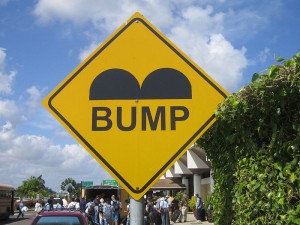 In Montana there is a bit of an unspoken rule when dealing with warning signs along roadways. The further in advance the placement of the warning sign from the road condition for which it warns, the smaller the occurrence of that particular road condition.
In Montana there is a bit of an unspoken rule when dealing with warning signs along roadways. The further in advance the placement of the warning sign from the road condition for which it warns, the smaller the occurrence of that particular road condition.
For example: If you are motoring down highway 93 and you spot a sign warning you of an imminent “Bump” at the same time you spot an irregularity in the pavement no further than fifty feet past the sign, then you best hit the breaks. ‘Cause it’s gonna’ be a doozy. On the other hand, if you fail to see any irregularities in the road what so ever until you have driven another mile, then you can ignore the warning all together. A bump a mile after the warning will end up feeling like nothing more than a pimple of asphalt beneath your tires.
I’ve been wondering if this is how sign posts and warnings should work in real life and good story as well.
